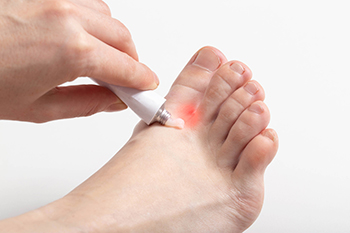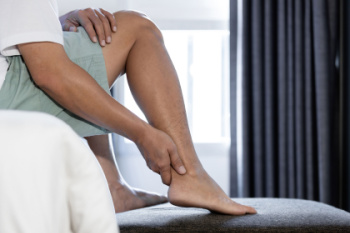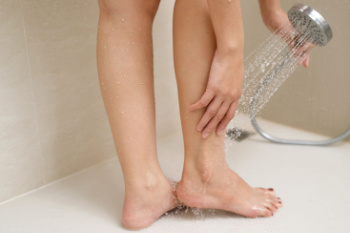Items filtered by date: April 2024
Evaluating Chronic Foot Pain
 Chronic foot pain can result from many conditions, including plantar fasciitis, arthritis, diabetes-related neuropathy, and repetitive stress injuries. These conditions can lead to ongoing discomfort, affecting mobility and quality of life. Effective diagnosis often begins with a comprehensive evaluation by a podiatrist, who will review the patient’s medical history and conduct a physical examination. Podiatrists may utilize imaging tests like X-rays, MRIs, or CT scans to view the internal structure of the foot and identify any underlying issues. These tests help the doctor confirm or eliminate certain conditions from the diagnosis by giving a detailed picture of what is happening in the foot. Gait analysis might also be performed to assess how the individual stands and walks, pinpointing abnormal movements that could contribute to the pain. Getting the right diagnosis is important so the podiatrist can create a customized treatment strategy to address the chronic pain. If you are suffering from chronic foot pain, it is suggested that you make an appointment with a podiatrist today.
Chronic foot pain can result from many conditions, including plantar fasciitis, arthritis, diabetes-related neuropathy, and repetitive stress injuries. These conditions can lead to ongoing discomfort, affecting mobility and quality of life. Effective diagnosis often begins with a comprehensive evaluation by a podiatrist, who will review the patient’s medical history and conduct a physical examination. Podiatrists may utilize imaging tests like X-rays, MRIs, or CT scans to view the internal structure of the foot and identify any underlying issues. These tests help the doctor confirm or eliminate certain conditions from the diagnosis by giving a detailed picture of what is happening in the foot. Gait analysis might also be performed to assess how the individual stands and walks, pinpointing abnormal movements that could contribute to the pain. Getting the right diagnosis is important so the podiatrist can create a customized treatment strategy to address the chronic pain. If you are suffering from chronic foot pain, it is suggested that you make an appointment with a podiatrist today.
Foot Pain
Foot pain can be extremely painful and debilitating. If you have a foot pain, consult with Dr. Thomas E. Silver from Westwood Foot Clinic. Our doctor will assess your condition and provide you with quality foot and ankle treatment.
Causes
Foot pain is a very broad condition that could be caused by one or more ailments. The most common include:
- Bunions
- Hammertoes
- Plantar Fasciitis
- Bone Spurs
- Corns
- Tarsal Tunnel Syndrome
- Ingrown Toenails
- Arthritis (such as Gout, Rheumatoid, and Osteoarthritis)
- Flat Feet
- Injury (from stress fractures, broken toe, foot, ankle, Achilles tendon ruptures, and sprains)
- And more
Diagnosis
To figure out the cause of foot pain, podiatrists utilize several different methods. This can range from simple visual inspections and sensation tests to X-rays and MRI scans. Prior medical history, family medical history, and any recent physical traumatic events will all be taken into consideration for a proper diagnosis.
Treatment
Treatment depends upon the cause of the foot pain. Whether it is resting, staying off the foot, or having surgery; podiatrists have a number of treatment options available for foot pain.
If you have any questions, please feel free to contact our office located in Golden Valley, MN . We offer the newest diagnostic and treatment technologies for all your foot care needs.
What Is Athlete’s Foot?
 Athlete's foot is a fungal infection that affects the skin of the feet. It's caused by various types of fungi that thrive in warm, moist environments. Athlete’s foot is commonly contracted in places such as locker rooms, swimming pools, and communal showers. When the feet are exposed to these fungi, they can easily penetrate the skin, leading to the development of athlete's foot. Factors such as wearing tight or poorly ventilated shoes, sweating excessively, or having a weakened immune system can increase the risk of developing athlete’s foot. Athlete’s foot is highly contagious and can spread through direct contact with infected skin or by sharing contaminated items like towels or shoes. Symptoms of athlete's foot include itching, redness, and peeling of the skin between the toes or on the soles of the feet. Podiatrists, or foot doctors, are well-equipped to diagnose and treat athlete's foot. They may offer treatments, such as antifungal medications and topical treatments to help patients find relief. If you suspect athlete’s foot, it is suggested that you consult a podiatrist for prompt treatment.
Athlete's foot is a fungal infection that affects the skin of the feet. It's caused by various types of fungi that thrive in warm, moist environments. Athlete’s foot is commonly contracted in places such as locker rooms, swimming pools, and communal showers. When the feet are exposed to these fungi, they can easily penetrate the skin, leading to the development of athlete's foot. Factors such as wearing tight or poorly ventilated shoes, sweating excessively, or having a weakened immune system can increase the risk of developing athlete’s foot. Athlete’s foot is highly contagious and can spread through direct contact with infected skin or by sharing contaminated items like towels or shoes. Symptoms of athlete's foot include itching, redness, and peeling of the skin between the toes or on the soles of the feet. Podiatrists, or foot doctors, are well-equipped to diagnose and treat athlete's foot. They may offer treatments, such as antifungal medications and topical treatments to help patients find relief. If you suspect athlete’s foot, it is suggested that you consult a podiatrist for prompt treatment.
Athlete’s Foot
Athlete’s foot is often an uncomfortable condition to experience. Thankfully, podiatrists specialize in treating athlete’s foot and offer the best treatment options. If you have any questions about athlete’s foot, consult with Dr. Thomas E. Silver from Westwood Foot Clinic. Our doctor will assess your condition and provide you with quality treatment.
What Is Athlete’s Foot?
Tinea pedis, more commonly known as athlete’s foot, is a non-serious and common fungal infection of the foot. Athlete’s foot is contagious and can be contracted by touching someone who has it or infected surfaces. The most common places contaminated by it are public showers, locker rooms, and swimming pools. Once contracted, it grows on feet that are left inside moist, dark, and warm shoes and socks.
Prevention
The most effective ways to prevent athlete’s foot include:
- Thoroughly washing and drying feet
- Avoid going barefoot in locker rooms and public showers
- Using shower shoes in public showers
- Wearing socks that allow the feet to breathe
- Changing socks and shoes frequently if you sweat a lot
Symptoms
Athlete’s foot initially occurs as a rash between the toes. However, if left undiagnosed, it can spread to the sides and bottom of the feet, toenails, and if touched by hand, the hands themselves. Symptoms include:
- Redness
- Burning
- Itching
- Scaly and peeling skin
Diagnosis and Treatment
Diagnosis is quick and easy. Skin samples will be taken and either viewed under a microscope or sent to a lab for testing. Sometimes, a podiatrist can diagnose it based on simply looking at it. Once confirmed, treatment options include oral and topical antifungal medications.
If you have any questions, please feel free to contact our office located in Golden Valley, MN . We offer the newest diagnostic and treatment technologies for all your foot care needs.
Various Types of Achilles Tendon Injuries

Achilles tendon injuries encompass various conditions affecting the Achilles tendon, the large tendon connecting the calf muscles to the heel bone. Tendonitis involves inflammation of the tendon due to overuse or repetitive stress, causing pain and swelling along the back of the lower leg or above the heel. Tendinosis refers to chronic degeneration of the Achilles tendon, often resulting from untreated or recurrent tendonitis. This condition may manifest as persistent pain and stiffness in the affected area. Paratenonitis affects the outer layer of the tendon, causing pain and swelling around the tendon rather than within it. Insertional Achilles tendinitis occurs at the point where the tendon inserts into the heel bone, leading to pain, swelling, and sometimes the formation of a bony bump. Treatment may involve rest, anti-inflammatory medications, custom-made orthotic devices, and in severe cases, surgical intervention to repair or remove damaged tissue. If you suffer from Achilles pain, it is suggested that you schedule an appointment with a podiatrist for a treatment plan tailored to your condition and the severity of the injury.
Achilles tendon injuries need immediate attention to avoid future complications. If you have any concerns, contact Dr. Thomas E. Silver of Westwood Foot Clinic. Our doctor can provide the care you need to keep you pain-free and on your feet.
What Is the Achilles Tendon?
The Achilles tendon is a tendon that connects the lower leg muscles and calf to the heel of the foot. It is the strongest tendon in the human body and is essential for making movement possible. Because this tendon is such an integral part of the body, any injuries to it can create immense difficulties and should immediately be presented to a doctor.
What Are the Symptoms of an Achilles Tendon Injury?
There are various types of injuries that can affect the Achilles tendon. The two most common injuries are Achilles tendinitis and ruptures of the tendon.
Achilles Tendinitis Symptoms
- Inflammation
- Dull to severe pain
- Increased blood flow to the tendon
- Thickening of the tendon
Rupture Symptoms
- Extreme pain and swelling in the foot
- Total immobility
Treatment and Prevention
Achilles tendon injuries are diagnosed by a thorough physical evaluation, which can include an MRI. Treatment involves rest, physical therapy, and in some cases, surgery. However, various preventative measures can be taken to avoid these injuries, such as:
- Thorough stretching of the tendon before and after exercise
- Strengthening exercises like calf raises, squats, leg curls, leg extensions, leg raises, lunges, and leg presses
If you have any questions please feel free to contact our office located in Golden Valley, MN . We offer the newest diagnostic tools and technology to treat your foot and ankle needs.
The Importance of Practicing Foot Hygiene
 Good foot hygiene is an important part of overall health and involves several key practices. Daily foot care should include washing your feet with soap and water to remove dirt and bacteria, and thoroughly drying them afterward to prevent fungal infections. Applying moisturizer can help keep the skin from becoming dry and cracked. Nails should be trimmed straight across and not too short to avoid ingrown toenails and infections. A daily inspection of your feet for any cuts, blisters, redness, or swelling can help to catch potential problems early, especially for those with diabetes or circulation issues. It is also important to keep your shoes clean on the inside and outside. Regular check-ups with a podiatrist, or foot doctor, enhance these daily practices by providing professional assessment and treatment of any foot issues. Podiatrists can offer advice tailored to your specific foot health needs and create plans to maintain overall foot wellness. To help support your foot health and overall quality of life, make an appointment with a podiatrist today.
Good foot hygiene is an important part of overall health and involves several key practices. Daily foot care should include washing your feet with soap and water to remove dirt and bacteria, and thoroughly drying them afterward to prevent fungal infections. Applying moisturizer can help keep the skin from becoming dry and cracked. Nails should be trimmed straight across and not too short to avoid ingrown toenails and infections. A daily inspection of your feet for any cuts, blisters, redness, or swelling can help to catch potential problems early, especially for those with diabetes or circulation issues. It is also important to keep your shoes clean on the inside and outside. Regular check-ups with a podiatrist, or foot doctor, enhance these daily practices by providing professional assessment and treatment of any foot issues. Podiatrists can offer advice tailored to your specific foot health needs and create plans to maintain overall foot wellness. To help support your foot health and overall quality of life, make an appointment with a podiatrist today.
Everyday foot care is very important to prevent infection and other foot ailments. If you need your feet checked, contact Dr. Thomas E. Silver from Westwood Foot Clinic. Our doctor can provide the care you need to keep you pain-free and on your feet.
Everyday Foot Care
Often, people take care of their bodies, face and hair more so than they do for their feet. But the feet are a very important aspect of our bodies, and one that we should pay more attention to. Without our feet, we would not be able to perform most daily tasks.
It is best to check your feet regularly to make sure there are no new bruises or cuts that you may not have noticed before. For dry feet, moisturizer can easily be a remedy and can be applied as often as necessary to the affected areas. Wearing shoes that fit well can also help you maintain good foot health, as well as making it easier to walk and do daily activities without the stress or pain of ill-fitting shoes, high heels, or even flip flops. Wearing clean socks with closed shoes is important to ensure that sweat and bacteria do not accumulate within the shoe. Clean socks help to prevent Athlete’s foot, fungi problems, bad odors, and can absorb sweat.
If you have any questions please feel free to contact our office located in Golden Valley, MN . We offer the newest diagnostic and treatment technologies for all your foot and ankle needs.
Heel Pain Can Be Treated!
The Prevalence of Bunions
 Bunions, characterized by a bony bump that forms at the base of the big toe, affect a significant portion of the population. This deformity arises when the big toe begins to lean toward the second toe, causing the structure of the foot to change and result in a bump at the big toe joint. Factors contributing to bunion development include genetic predisposition, footwear choices, and certain foot structures. More women than men have bunions, due to wearing narrow, tight-fitting shoes and high heels that place undue pressure on the forefoot. However, anyone can develop bunions, and they are increasingly observed across all age groups, from teenagers to the elderly. The widespread nature of this condition shows the importance of recognizing early symptoms and seeking appropriate treatment. A podiatrist, or foot doctor, has the specialized knowledge of the foot to properly treat and prevent bunions. It is suggested you schedule an appointment with a podiatrist if you have a bunion to prevent its progression.
Bunions, characterized by a bony bump that forms at the base of the big toe, affect a significant portion of the population. This deformity arises when the big toe begins to lean toward the second toe, causing the structure of the foot to change and result in a bump at the big toe joint. Factors contributing to bunion development include genetic predisposition, footwear choices, and certain foot structures. More women than men have bunions, due to wearing narrow, tight-fitting shoes and high heels that place undue pressure on the forefoot. However, anyone can develop bunions, and they are increasingly observed across all age groups, from teenagers to the elderly. The widespread nature of this condition shows the importance of recognizing early symptoms and seeking appropriate treatment. A podiatrist, or foot doctor, has the specialized knowledge of the foot to properly treat and prevent bunions. It is suggested you schedule an appointment with a podiatrist if you have a bunion to prevent its progression.
If you are suffering from bunions, contact Dr. Thomas E. Silver of Westwood Foot Clinic. Our doctor can provide the care you need to keep you pain-free and on your feet.
What Is a Bunion?
A bunion is formed of swollen tissue or an enlargement of boney growth, usually located at the base joint of the toe that connects to the foot. The swelling occurs due to the bones in the big toe shifting inward, which impacts the other toes of the foot. This causes the area around the base of the big toe to become inflamed and painful.
Why Do Bunions Form?
Genetics – Susceptibility to bunions are often hereditary
Stress on the feet – Poorly fitted and uncomfortable footwear that places stress on feet, such as heels, can worsen existing bunions
How Are Bunions Diagnosed?
Doctors often perform two tests – blood tests and x-rays – when trying to diagnose bunions, especially in the early stages of development. Blood tests help determine if the foot pain is being caused by something else, such as arthritis, while x-rays provide a clear picture of your bone structure to your doctor.
How Are Bunions Treated?
- Refrain from wearing heels or similar shoes that cause discomfort
- Select wider shoes that can provide more comfort and reduce pain
- Anti-inflammatory and pain management drugs
- Orthotics or foot inserts
- Surgery
If you have any questions, please feel free to contact our office located in Golden Valley, MN . We offer the newest diagnostic and treatment technologies for all your foot care needs.

